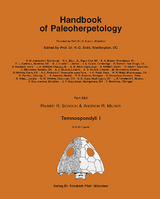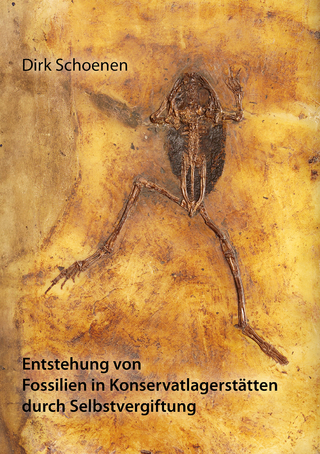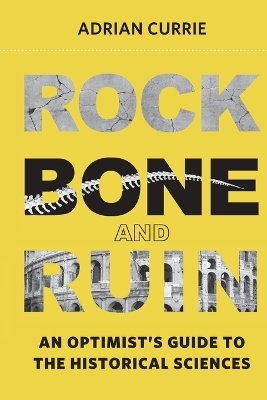Handbook of Paleoherpetology / Temnospondyli I
Seiten
The present volume, Temnospondyli I by Drs. R. R. SCHOCH (Stuttgart) and A. R. MILNER (London), represents the long-awaited companion to Part 3B by the same team of authors, which dealt with one major clade of temnospondyls, Stereospondyli. A third volume (Part 3A1) by Professor J. A. CLACK and Dr. A. R. MILNER will discuss stem tetrapods and the proximate sister-taxa of Tetrapoda (Tetrapodomorpha). Such has been the pace of discoveries of and research on stem amphibians and stem tetrapods in recent decades that the editor and publisher decided to issue Volume 3 of the Handbook of Paleoherpetology in three rather than two parts to do justice to the wealth of available information. It is to be hoped that these syntheses will provide important sources of data for all researchers concerned with the early evolution of tetrapods.
Although temnospondyls have been the subject of scientific study since the first half of the nineteenth century, these tetrapods received relatively little scientific attention for many years. ROMER’s (1947) monographic review of all taxa known at that time was foundational. It compiled and synthesized the widely scattered information on the diversity and morphology of temnospondyls and established a series of major grades among these tetrapods. During the second half of the twentieth century, the study of temnospondyls experienced a major renaissance. In addition to increasingly detailed studies on the morphology of previously known as well as new taxa, researchers explored the ontogeny of various temnospondyls and, using the explicitly phylogenetic methods, elucidate the evolutionary history of Temnospondyli, with special reference to their relationships to extant amphibians. The latter subject remains contentious, but most researchers now would argue for a sister-group relationship between one particular clade of Temnospondyli, Dissorophoidea, and at least Batrachia (comprising Anura and Caudata).
The authors of the present volume have long been the leaders in the study of temnospondyl morphology and phylogeny and have personally examined most of the important specimens. Most recently, SCHOCH (2013) published a major analysis of temnospondyl interrelationships, which provides the phylogenetic framework for the present review.
The authors and editor take great pleasure in thanking Dr. F. PFEIL for his continuing enthusiasm for and tireless support of the Handbook of Paleoherpetology.
Although temnospondyls have been the subject of scientific study since the first half of the nineteenth century, these tetrapods received relatively little scientific attention for many years. ROMER’s (1947) monographic review of all taxa known at that time was foundational. It compiled and synthesized the widely scattered information on the diversity and morphology of temnospondyls and established a series of major grades among these tetrapods. During the second half of the twentieth century, the study of temnospondyls experienced a major renaissance. In addition to increasingly detailed studies on the morphology of previously known as well as new taxa, researchers explored the ontogeny of various temnospondyls and, using the explicitly phylogenetic methods, elucidate the evolutionary history of Temnospondyli, with special reference to their relationships to extant amphibians. The latter subject remains contentious, but most researchers now would argue for a sister-group relationship between one particular clade of Temnospondyli, Dissorophoidea, and at least Batrachia (comprising Anura and Caudata).
The authors of the present volume have long been the leaders in the study of temnospondyl morphology and phylogeny and have personally examined most of the important specimens. Most recently, SCHOCH (2013) published a major analysis of temnospondyl interrelationships, which provides the phylogenetic framework for the present review.
The authors and editor take great pleasure in thanking Dr. F. PFEIL for his continuing enthusiasm for and tireless support of the Handbook of Paleoherpetology.
| Erscheint lt. Verlag | 8.4.2014 |
|---|---|
| Reihe/Serie | Handbook of Paleoherpetology ; 3A2 |
| Zusatzinfo | 53 Schwarzweißabbildungen |
| Sprache | englisch |
| Maße | 205 x 255 mm |
| Einbandart | gebunden |
| Themenwelt | Naturwissenschaften ► Geowissenschaften ► Mineralogie / Paläontologie |
| ISBN-10 | 3-89937-170-4 / 3899371704 |
| ISBN-13 | 978-3-89937-170-3 / 9783899371703 |
| Zustand | Neuware |
| Haben Sie eine Frage zum Produkt? |
Mehr entdecken
aus dem Bereich
aus dem Bereich
Buch | Softcover (2024)
Shaker (Verlag)
19,80 €
An Optimist's Guide to the Historical Sciences
Buch | Softcover (2024)
MIT Press (Verlag)
34,55 €




